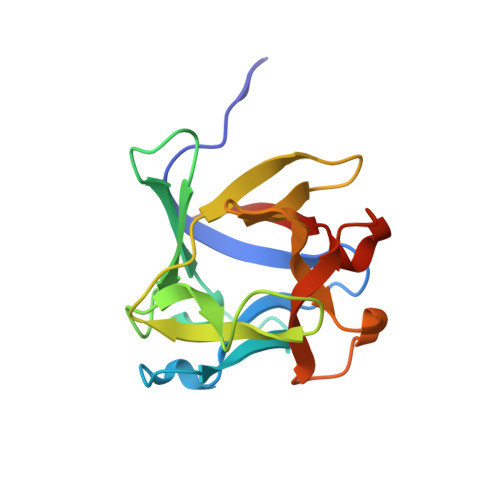Structural analysis of the Rhizoctonia solani agglutinin reveals a domain-swapping dimeric assembly.
Skamnaki, V.T., Peumans, W.J., Kantsadi, A.L., Cubeta, M.A., Plas, K., Pakala, S., Zographos, S.E., Smagghe, G., Nierman, W.C., Van Damme, E.J., Leonidas, D.D.(2013) FEBS J 280: 1750-1763
- PubMed: 23402398
- DOI: https://doi.org/10.1111/febs.12190
- Primary Citation of Related Structures:
4G9M, 4G9N - PubMed Abstract:
Rhizoctonia solani agglutinin (RSA) is a 15.5-kDa lectin accumulated in the mycelium and sclerotia of the soil born plant pathogenic fungus R. solani. Although it is considered to serve as a storage protein and is implicated in fungal insecticidal activity, its physiological role remains unclear as a result of a lack of any structure/function relationship information. Glycan arrays showed that RSA displays high selectivity towards terminal nonreducing N-acetylgalactosamine residues. We determined the amino acid sequence of RSA and also determined the crystal structures of the free form and the RSA-N-acetylgalactosamine complex at 1.6 and 2.2 Å resolution, respectively. RSA is a homodimer comprised of two monomers adopting the β-trefoil fold. Each monomer accommodates two different carbohydrate-binding sites in an asymmetric way. Despite RSA topology similarities with R-type lectins, the two-monomer assembly involves an N-terminal swap, thus creating a dimer association novel to R-type lectins. Structural characterization of the two carbohydrate-binding sites offers insights on the structural determinants of the RSA carbohydrate specificity. Structural data have been deposited in the Protein Data Bank database under accession numbers 4G9M and 4G9N. RSA and RSA bind by x-ray crystallography (View interaction).
Organizational Affiliation:
Department of Biochemistry and Biotechnology, University of Thessaly, Larissa, Greece.














